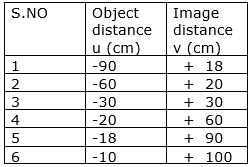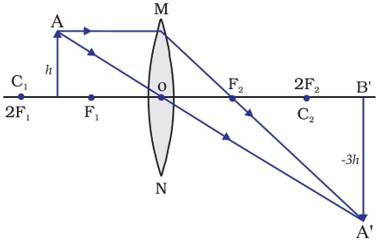Analyse the following observation table showing variation of image distance (v) with object distance (u) in case of a convex lens and answer the Question s that follow, without doing any calculations:

i. What is the focal length of the convex lens? Give reason in support of your answer.
ii. Write the serial number of the observation which is not correct. How did you arrive at this conclusion?
iii. Take an appropriate scale to draw ray diagram for the observation at S.No.4 and find the approximate value of magnification.
OR
i. To construct a ray diagram we use two rays which are so chosen that it is easy to know their directions after reflection from the mirror. List two such rays and state the path of these rays after reflection in case of concave mirrors. Use these two rays and draw ray diagram to locate the image of an object placed between pole and focus of a concave mirror.
ii. A concave mirror produces three times magnified image on a screen. If the object is place 20 cm in front of the mirror, how far is the screen from the object?
i. For observation no.3 clearly shows that the focal length is + 15 cm.
When an object is placed at 2F1 of a convex lens, image is formed at the opposite 2F2 point. For this mirror 2F = 30 cm, we get f = + 15 cm.
ii. Clearly the observation no. 6 is wrong as the image distance should have been negative but it is given that it is positive.
This is so because a convex lens produces a virtual image when the object is between focus and the optical centre.
iii. Magnification is given by,
![]()

OR

i. The two rays are originating from the top of the object. One is passing through the spherical centre of the mirror and the other ray is passing through the pole of the mirror.
ii. Magnification is given by,
![]()
![]()
So the distance between the screen and the object is 60-20 = 40 cm.